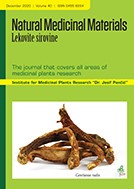Institute for Medicinal Plants Research "Dr. Josif Pančić" , Belgrade , Serbia
Institute for Medicinal Plants Research "Dr. Josif Pančić" , Belgrade , Serbia
Institute for Medicinal Plants Research "Dr. Josif Pančić" , Belgrade , Serbia
Lady’s mantle (Alchemilla vulgaris L. syn. Alchemilla xanthochlora Rothm., Rosaceae) has been commonly used in folk medicine to heal inflammations in the mouth, bleeding of the nose, furuncules, gynaecological (menorrhagia and dysmenorrhoea), and gastrointestinal disorders. Although therapeutic indications for Lady’s mantle are non-specific diarrhoea and gastrointestinal complaints, it has been reported to exert, as well, a variety of biological activities, including wound healing, antimicrobial, neuroprotective, gastroprotective, cytotoxic, and antioxidant. Lady’s mantle presents a valuable source of natural bioactive compounds, mostly phenolic compounds – a large amount of tannins, phenolcarboxylic acids, and flavonoids, being responsible for the abovementioned effects. In this work, a literature review of biological properties, investigated in in vitro and in vivo experiments in regard to the determined chemical profile is presented. In addition, the data reported are discussed, and the directions for further investigations are proposed.
This is an open access article distributed under the Creative Commons Attribution License which permits unrestricted use, distribution, and reproduction in any medium, provided the original work is properly cited.

The statements, opinions and data contained in the journal are solely those of the individual authors and contributors and not of the publisher and the editor(s). We stay neutral with regard to jurisdictional claims in published maps and institutional affiliations.